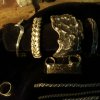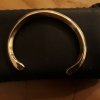Golden ChipMunk
Well-Known Member
Invitation to All SilverSmith / GoldSmith
Love to see SilverSmith that doing casting, jewelry ... etc; your work or some work you bought.
Rookies to Experts , Can you show us..... what you make and have....
Love to see SilverSmith that doing casting, jewelry ... etc; your work or some work you bought.
Rookies to Experts , Can you show us..... what you make and have....














